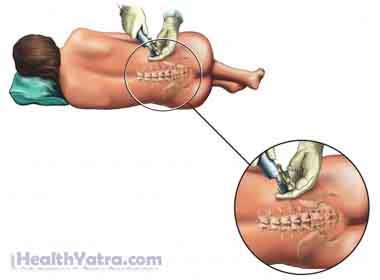Definition
These two types of anesthesia numb your body from the chest down to the legs. The medicine is placed directly into the spine area.
Reasons for Procedure
Spinal and epidural anesthesia is frequently given for surgeries involving:
- Pelvis, hips, and legs
- Childbirth
Advantages of these types of anesthesia include:
- Ability to be awake during the operation
- Avoid complications of general anesthesia
Possible Complications
Complications are rare, but no procedure is completely free of risk. If you are planning to have spinal and epidural anesthesia, your doctor will review a list of possible complications, which may include:
- Severe headache or back pain
- Drop in blood pressure
- Nerve damage
- Infection
- Allergic reaction to the anesthetic used
- Longer labor during childbirth (epidural anesthesia)
Some factors that may increase the risk of complications include:
- Smoking
- Bleeding disorders
- Prior allergic reactions to anesthetics
- Dehydration
- Immune system disorders
Be sure to discuss these risks with your doctor before the surgery.
What to Expect
Prior to Procedure
Make sure that your doctor is aware of:
- Your drug allergies
- Medicines you are taking
- Any heart or lung conditions you have
- Any previous reactions that you or other family members have had to anesthesia
- Any bleeding problems you have had in the past
Description of the Procedure
You will be connected to various monitors to keep track of your:
- Blood pressure
- Pulse
- Oxygen content of your blood
You may also have:
- An IV line to provide you with fluids
- A catheter (tube) put into your bladder to keep urine drained
An area on your back above the spinal cord will be cleaned. A local anesthetic will be injected into the skin to numb the area. This is to decrease pain from the larger needle that will be put in your back. If you are getting spinal anesthesia, the doctor will give you one injection. The medicine will be sent directly into the sac of fluid that surrounds the spinal cord.
If you are getting epidural anesthesia, it may be delivered the same way. But, if you need more than one dose, you will have a tiny, flexible tube in place just outside of the fluid sac. This allows the doctor to give you more medicine if you need it. After the surgery, the doctor will place a bandage over the injection spot.

Immediately After Procedure
- After spinal anesthesia—You may be told to stay in bed with your head flat for several hours. This is to prevent a headache.
- After either spinal or epidural anesthesia—You will stay in bed until your legs are no longer numb.
How Long Will It Take?
Giving spinal or epidural anesthesia usually takes about 15 minutes.
- Spinal anesthesia—begins working right after the injection is given
- Epidural anesthesia—takes about 10-20 minutes to begin working
How Much Will It Hurt?
You will feel some pain when the needle is inserted.
Average Hospital Stay
This depends on the type of surgery being done.
Postoperative Care
At the Hospital
If you received epidural anesthesia, the tube may be left in place to give you more medicine. When you no longer need pain control, the doctor will remove the tube.
At Home
When you return home, do the following to help ensure a smooth recovery:
- For the first 24 hours:
- Do not drive or operate machinery.
- Do not drink alcohol.
- Be sure to follow your doctor’s instructions.
Call Your Doctor
After you leave the hospital, contact your doctor if any of the following occur:
- Signs of infection, including fever and chills
- Persistent or severe headache or back pain
- Dizziness, fainting
- Weakness, numbness, or tingling in your arms or legs
- Loss of bladder or bowel control
- Skin rash
- Difficulty breathing
In case of an emergency, call for medical help right away.
